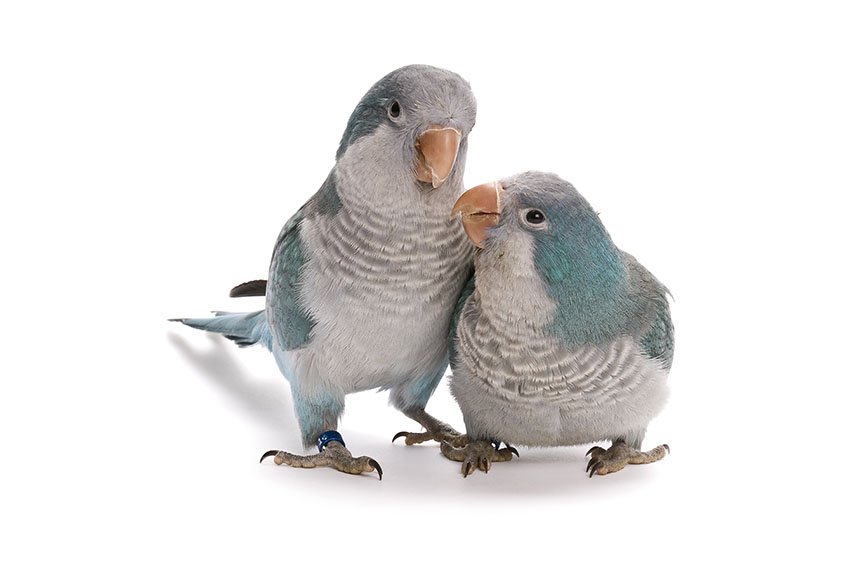There are many things that can go wrong when you’re trying to breed parrots:
- Calcium deficiency can result in egg-binding, so make sure females have plenty of calcium in their diet. The nesting hen can be attacked by a stressed male, so keep an eye on the pair to make sure they’re cohabiting happily. Several things can cause the male to ‘snap’, usually lack-of-space-related issues, or the presence of noisy and territorial neighbours (human, canine, feline and avian alike!)
- Territorial males can spend all their energies on aggression, to such an extent that the added pressure of feeding chicks actually kills them.
- A breeding pair of the same – or closely related – species can be the source of stress and aggression.

Breeding parrots like this Blue Quaker pair need a stress-free environment
- A frustrated male, unable to get his beak and claws on the rival in the next cage, may take his anger out on the nesting female, the eggs, or the chicks. Screening the nest-box section of the aviary with a solid partition can help defuse rivalries, with an ‘out of sight, out of mind’ logic (parrots being very visually-stimulated animals).
- If it’s too cold, the birds will not breed. Nesting areas should be heated to a temperature recommended for your particular species of parrot.
- Some pairs simply don’t hit it off. In this case, you will have to introduce a new prospective partner to the female (removing the unsuccessful/disinterested male first). Note: if you are keeping a flock bird like a cockatiel or budgerigar, the group can pair off without your intervention, which is one of the reasons why flock birds are so popular.
- Older birds will be less inclined to pair off and heed the call of nature. Young birds are more inclined to breed, and anyone new to parrot breeding should start with healthy specimens in their first year. (A reputable breeder is an absolute must here, to ensure young, healthy birds of the correct sex!)
- Many breeders temporarily separate paired birds for a week. When reintroduced, they are usually sufficiently excited to stimulate breeding hormones.
- It’s a good idea to keep plenty of fresh branches and foliage in your nesting aviary, as your parrots will instinctively respond to an environment that mimics the bird’s wild breeding habitat.
Comments
Simon, 28 November 2023
i love parrots so so much
Berkay, 14 May 2020
hello ı am love parrots
James, 4 May 2020
Hi there, it may seem a bit of a silly question...but are blue quaker parrot able to successfully breed with quaker green or yellow quaker parrots? I know that there are some size differences between blue quakers. Many thanks!
Kate, 25 February 2020
I have an African Grey, which we thought was male and was kept in a cage for 10 years, but now she is allowed to roam around, she has built herself a nest in a cupboard and laid two eggs. We introduced her to a 15 year old male, and she seems attracted ('kissing', sharing food), but he was nervous. Should I bring the male home, and, if so, should he stay in a cage for a while before I allow them time together? During the summer, the female lives in a 4m x 1.5m x 2m aviary in the garden; it has a nestbox and living plants.
Zubair, 9 February 2020
have a pair of cocktail parrot but the problem is that I havent get any male parrot out of them. Up till now I got 4 breads out of them. Please suggest if there is any solution.